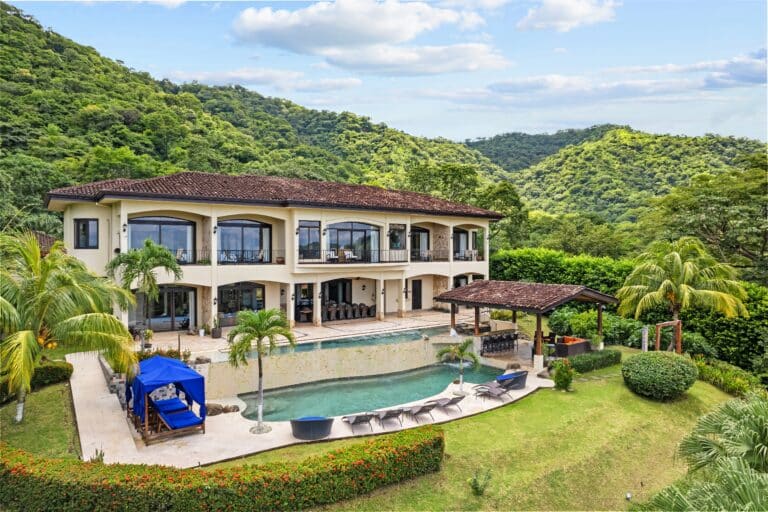Located on the edge of Playas del Coco, Villa Buena Onda is surrounded by the lush tropical dry forest on all sides. For this reason, we commonly have visits from some of Costa Rica’s most exotic native animals.
Guanacaste is an ecotourist’s dream. As a habitat to hundreds of species, some animals that make their home in Guanacaste include exotic birds, monkeys, armadillos, iguanas, crocodiles, raccoons, coatis, and pumas.
Monkeys
Of the four species of monkeys in Costa Rica, Howler monkeys are very frequent guests at the Villa. They like to stay high up in the Guanacaste trees which can make them tricky to spot. We promise that you will know when they are on the property! They live up to their name with their haunting howl.
The Villa also gets occasional visits from spider monkeys and white-faced capuchin monkeys. The squirrel monkeys prefer to be inland and are hard to spot in Guanacaste.
Known for their long limbs, spider monkeys are the largest monkeys in Costa Rica, and can grow up to 90 centimeters (35 inches) long. Spider monkeys like to forage up high in the primary rainforest like the kind you will find in nearby Rincón de la Vieja National Park.
While much smaller, Capuchin monkeys are considered the smartest monkeys in Costa Rica. These monkeys are best found in unpopulated areas like secluded beaches and national parks.
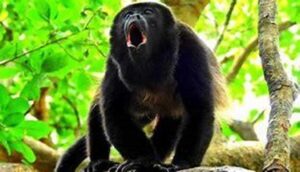

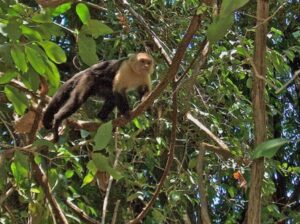
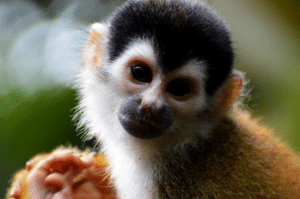
Reptiles of Guanacaste
There are 38 species of iguanas in Costa Rica, with green iguanas and black iguanas being the most common. They prefer the dry climate found along Guanacaste’s northern coast, so they will be easily found at Villa Buena Onda. In Costa Rica, the iguana is sometimes referred to as “gallina de palo”, which means chicken of the tree, as it was once considered a good source of meat.
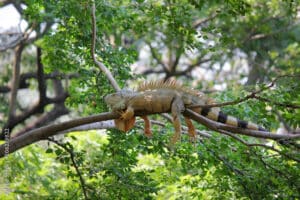
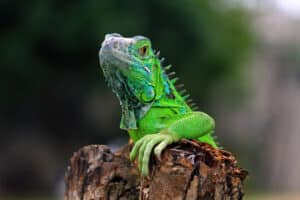
Both the American crocodile and the caiman are among the largest native animals in Costa Rica. Caimans are generally shyer and smaller than crocodiles. While an adult caiman averages 2.5 meters (8 feet) in length, the crocodile (called Cocodrilo in Costa Rica) averages 4 meters (13 feet) long. Who wins in a fight between a croc and an alligator? Always bet on the croc!
Who wins in a fight between a croc or alligator? Always bet on the croc.
Crocodile vs Caiman
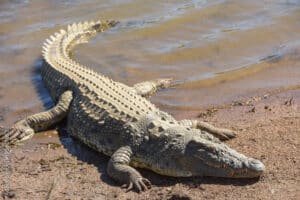
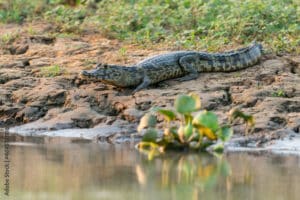
Both the American crocodile and the caiman are among the largest native animals in Costa Rica. Caimans are generally shyer and smaller than crocodiles. While an adult caiman averages 2.5 meters (8 feet) in length, the crocodile (called Cocodrilo in Costa Rica) averages 4 meters (13 feet) long. Who wins in a fight between a croc and an alligator? Always bet on the croc!
At Villa Buena Onda, you may also see the famous basilisk lizard. These small lizards are also known as the Jesus Christ Lizard thanks to their uncanny ability to run across the water for up to 20 meters (65 feet).
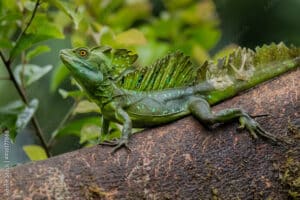
Luckily, the Fer de Lance and other lethal snakes much prefer the inland jungles over the drier climate of Guanacaste. This guy is not to be trifled with!
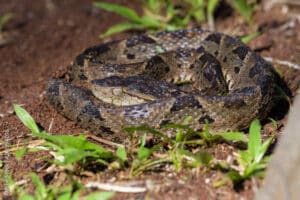
Coatis of Guanacaste
The white-nosed coati, also known as coatimundi or pizote locally, can be found in most areas of Costa Rica, especially near the coast. Belonging to the same family as raccoons, the coati looks quite like the raccoon save for its elongated snout.
These animals tend to be seen in groups of 10 to 30 and can often be found wherever there is food easily available. In fact, you are likely to encounter this unique mammal if you take a catamaran tour to a secluded beach. They will hang around looking for a handout at the beach barbecue of a typical boat tour. It is best to note that it is illegal to feed wild animals in Costa Rica, but these cute creatures will try to convince you otherwise!
Coatis are quite common and can resemble a (ROUS) straight from the fire swamp on “A Princess Bride”. They mostly avoid humans who don’t feed them (as you would wish).
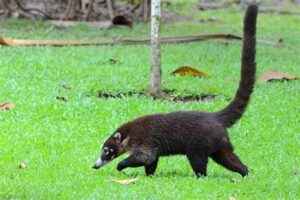
Baird’s Tapir
The Tapir is an animal that is found mainly in moist, dense forests in the more temperate regions of the Southern Hemisphere. The Baird’s Tapir (the Spanish name is Danta) can be found in the tropical rainforest of Costa Rica. The Tapirs can be found in several national parks of Costa Rica, such as Tenorio Volcano National Park, Santa Rosa National Park, La Selva, Cerro de la Muerte, Corcovado National Park, Penas Blancas National Park, Santa Elena Cloud Forest Reserve, and Monteverde Cloud Forest Reserve.
Baird’s Tapir is the largest land mammal in Costa Rica. This cutie is often 4ft tall x 6ft long and 500lbs.
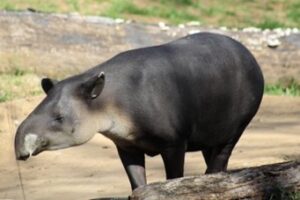
Sloths
Arguably, sloths are the most coveted of the native animals in Costa Rica. Everyone who steps foot in the Costa Rican rainforests hopes to catch a glimpse of a sloth. Costa Rica is home to two sloth species – the larger Two-Toed Sloth, and the Brown-Throated Three-Toed Sloth.
Sloths spend most of their lives upside down and move very little distance throughout their entire life. They can be spotted hanging in the trees of the rainforests and cloud forests in Costa Rica. Sloths have three times the strength of the average human.
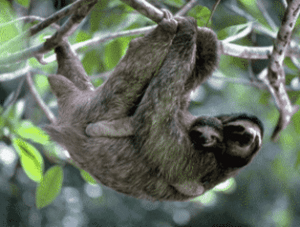
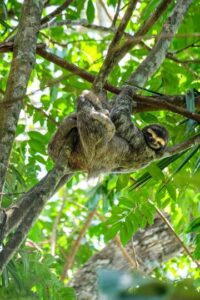
Wild Cats of Guanacaste
Costa Rica is home to six species of wild cats, including the jaguar, puma, ocelot, oncilla, margay, and jaguarundi. Although seeing one in the wild is extremely rare, five of these wildcats are likely to be found in the vast province of Guanacaste and are sometimes spotted by wildlife cameras set up in the forest.
Outside of the nearby sanctuary, you probably won’t spot any of the 6 Costa Rican cats while at VBO. Your best bet for a sighting is the Ocelot (25lbs & 30 inches)
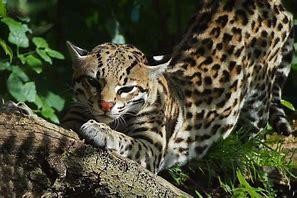
Birds of Guanacaste
Costa Rica has a total of 925 species of birds, which is more than nine percent of the world’s population. Acting as a biological bridge between North and South America, Costa Rica is one of five places in the world that sees a migration of three million birds of prey. In the wetlands of Guanacaste, such as the Palo Verde National Park, thousands of migratory and native birds can be seen between December and March. It remains a bird watcher’s paradise during the rest of the year with hummingbirds, shorebirds, thrushes, warblers, orioles, tanagers, and macaws.
The Yigüirro is the National Bird of Costa Rica. It was picked as the national bird for several reasons. First, it tends to live next to humans, staying close to houses and settlements, which has made it well-known among Ticos in both rural and suburban environments. Because of this close relationship, the bird has been mentioned in many of Costa Rica’s folk songs, poems, novels, and short stories. But, as I said before, the clay-colored thrush also has a melody of its own.
These birds are consistent morning friends at VBO. Guess the names!



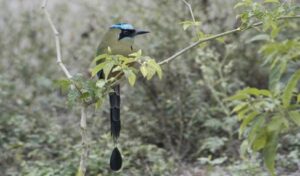
Langosta (Grasshopper)
The langosta is not your typical grasshopper, though, it looks quite similar in shape. With their gorgeous bright colors and bright red boots, langostas range around 5 to 6 inches in length and look like birds while fluttering their 18-inch wings in flight. These beautiful insects are night creatures, so it’s rare to see them during the day.
Even a common 6-inch banana leaf-eating Langosta grasshopper looks exotic in Costa Rica.

Fish
Fishers have a great time trying to catch the tuna, wahoo, machaca, snook, and the famous rainbow bass (also known as the guapote). If you are more interested in snorkeling or scuba diving in Costa Rica you can see spotted eagle rays, starfish, eels, sea turtles, dolphins, angel fish, seahorses, and octopus!
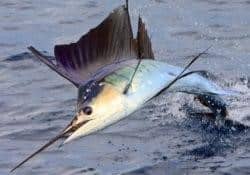
Dolphins
Dolphins often tag along on our fishing and snorkeling trips during the best tours in Guanacaste, Costa Rica.
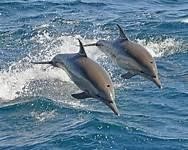
Whales
Whale watching is year-round, but August through October is the best for diversity. The 50-ton, 50-foot-long humpback is a main-stay.
Bryde’s whales, Humpback whales, Sei whales, Dyde whales, and Orca (killer) whales are also beloved.

Turtles
Turtles that come to Costa Rica are the Olive Ridley, the leatherback sea turtle, the green, and the hawksbill.

Amphibians
When you pick up a book on Costa Rica travel, you will likely see a colorful little frog gracing the cover. Costa Rica’s amphibians are possibly the most beautiful amongst the country’s fauna. With boundless color patterns, these creatures can be found in various sizes. From giant toads to tiny frogs, discover which ones you can find in Costa Rica!
Poison Dart Frogs
Poison Dart Frogs are also referred to as Arrow Frogs. There are currently 8 known species in Costa Rica (avoid licking)

Red – Eyed Frog
Also referred to as the gaudy leaf frog or red–eyed tree frog, it is easily recognized because of its hypnotic red eyes. You can spot these frogs throughout most of the country and once you are familiar with their distinctive call, you can even track them!
Some guests overdo the all-inclusive package (Red Eyed Frog)!
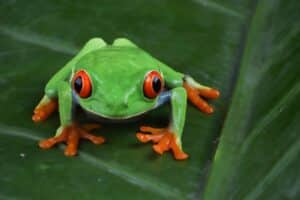
Glass Frog
The Glass Frogs are a little bit harder to spot so make sure to book an expert guide to help you. Does this little frog look familiar? That might be because Kermit the Frog is based on it!
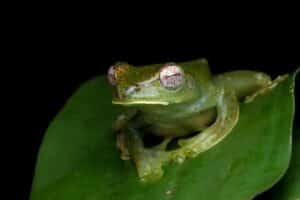
Lemur Leaf Frog
Lemur Leaf Frogs have sadly been dropping in population. The likely explanation for this is that like some other frog species, they have been exposed to a fungus that causes infectious diseases. Fortunately, measures are being taken to conserve them. It would be a shame to lose such a beautiful creature with silvery eyes and piercing green skin!

Cane Toad
The giant toad is native to South and Central America but has been introduced in many other parts of the world to combat pests like the cane beetle.
In Costa Rica, the cane toad can be helpful to reduce insect populations. The opportunistic animal has adapted well to human homes and with its immense appetite it devours all kinds of bugs, as itchy, toxic, and biting as it may be.
The very large (10-inch) but harmless Cane Toad has been known to steal a dip in our pool after sunset.
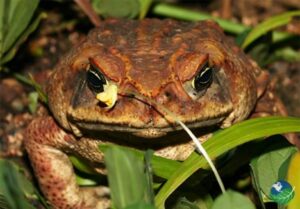
So, whether you choose to stay at Villa Buena Onda in Playas del Coco or embark on some of the best tours in Guanacaste, Costa Rica, you are sure to see plenty of Costa Rica’s native animals.

